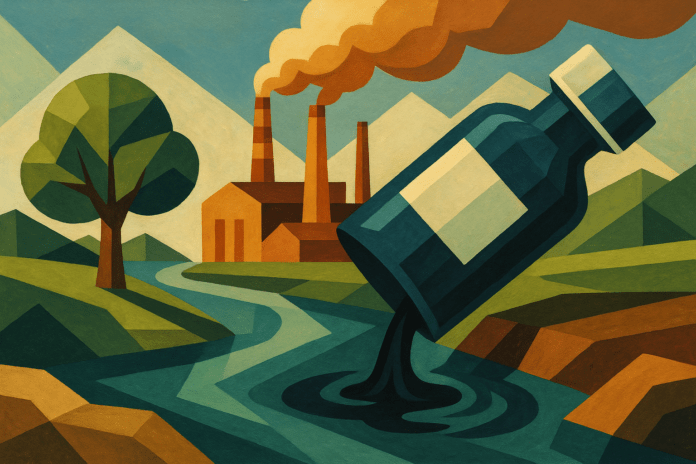The pharmaceutical sector, often perceived solely for its life-saving function, hides a darker side: its environmental impact. According to a recent international review (1), up to 96% of discarded medicines end up in unsafe channels, contaminating soil, surface waters, and drainage systems. The consequences are far from negligible: in samples taken from polluted areas, 60% of bacteria show resistance to antibiotics—evidence of the deep link between the environment and public health.
In Italy, the issue is confirmed: the Italian Medicines Agency (2) has highlighted that the consumption of antibiotics and analgesics accounts for the largest share of pharmaceutical residues detected in the environment. Added to this are ISTAT data (3): within the manufacturing sector, the chemical-pharmaceutical industry contributes 15.7% of CO₂-equivalent emissions and 17% of water discharges.
Sources of Pollution
Industrial discharges are not the only vector. Hospitals and healthcare facilities generate between 1 and 6 kilograms of pharmaceutical waste every day, with operating rooms and emergency departments among the largest contributors (1). Households also play a role: 82% of Italian citizens dispose of expired medicines in general waste or flush them down the toilet—a clear sign of limited awareness about proper disposal practices.
Another critical issue concerns production: in 2022, ISTAT reported that Italy’s energy intensity index was higher than the European average, with the pharmaceutical sector showing a particularly significant impact.
Europe’s Policy Response
The European Union has long recognized pharmaceutical-related environmental pollution as an emerging issue of major importance. Article 8c of Directive 2008/105/EC (amended by 2013/39/EU) tasked the Commission with developing a strategic approach to water contamination from pharmaceuticals, with the obligation to propose effective measures at either the EU or national level (4).
Directive 2013/39/EU of the European Parliament
At the regulatory level, Europe has therefore initiated a structured path. The Pharmaceutical Strategy for Europe (2020) introduced, for the first time, environmental impact among the criteria for evaluating medicines, while the Green Deal and the Circular Economy Action Plan strengthened the approach across the entire product life cycle.
These recommendations are closely aligned with the Pharmaceutical Strategy for Europe (2020), which identified as one of its pillars the promotion of safer, more effective, and “greener” medicines—those with a more sustainable environmental footprint.
Pharmaceutical Strategy for Europe (2020)
Another crucial regulatory development concerns the revision of the Urban Wastewater Treatment Directive (UWWTD), recast as Directive (EU) 2024/3019, which entered into force on 1 January 2025. This legislation requires Member States to introduce a “fourth treatment stage”—the removal of persistent substances through advanced technologies—by no later than July 2027. Furthermore, under the “polluter pays” principle, at least 80% of the costs of this additional treatment must be borne by the pharmaceutical and cosmetics industries.
Direttiva (UE) 2024/3019 del Parlamento Europeo e del Consiglio
Finally, at a broader regulatory level, the Water Framework Directive (WFD) already provides for a “watch list” of emerging substances. Since 2013, the Commission has begun adding certain pharmaceuticals (active substances) to this list in order to assess and manage their presence in aquatic environments.
Directive 2000/60/EC of the European Parliament and of the Council
Italy vs Europe
While Europe is accelerating, Italy is lagging behind. The 2022 ISTAT analysis shows that fewer than 20% of Italian pharmaceutical companies have adopted certified environmental management systems, compared with a European average of over 30%. Italy also appears behind on emissions reduction: in 2022, the decrease was 2.4% compared to 2019, against an EU average decline of 6.1%.
There are, however, encouraging signs: initiatives such as those promoted by Assogenerici, which support the recycling of plastic and aluminum blister packs, and pilot projects aimed at reducing the carbon footprint of biotech production. Some multinationals with plants in Italy have already adopted wastewater treatment systems based on advanced oxidation technologies, capable of eliminating up to 95% of antibiotic residues.
The comparison with Europe highlights Italy’s lag:
- CO₂ emissions reduction (2019–2022): Italy –2.4% vs EU –6.1%
- Companies with certified environmental management systems: Italy 19% vs EU 30%
Beyond Regulatory Compliance
The urgency is clear: without a change of course, the impacts risk becoming irreversible, compromising both ecosystems and human health. Proposals put forward by institutes such as I-Com and Farmacovigilanza.eu converge on three priorities:
-
Prevention at the source, by reducing waste and optimizing production processes.
-
Infrastructure for recovery and reuse, including widespread household collection campaigns.
-
Technological innovation, through advanced wastewater treatment systems and new “green by design” active substances.
In this context, the Italian pharmaceutical sector has the opportunity to shift from being an Achilles’ heel to becoming a virtuous model: given the industry’s export capacity and strategic weight, turning sustainability into a competitive advantage has become an urgent necessity.
Sources:
(1) Pharmaceutical waste management: sources, environmental impacts, and sustainable solutions, Pharmacy Reports
(2) Ridurre l’impatto ambientale dei farmaci, AIFA
(3) Statistica Focus Sostenibilità ambientale manifattura Anno 2022
(4) Pharmaceuticals and the Environment, Public Health EU


